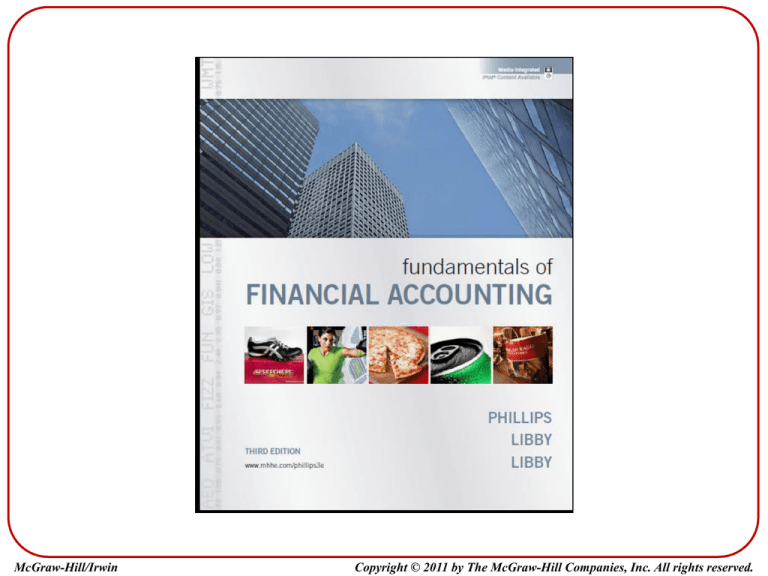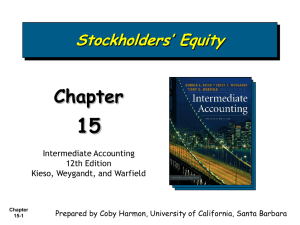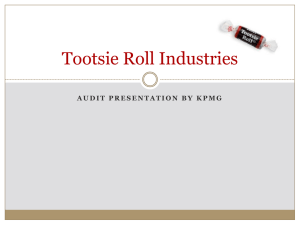
McGraw-Hill/Irwin
Copyright © 2011 by The McGraw-Hill Companies, Inc. All rights reserved.
Chapter 11
Reporting and Interpreting
Stockholders’ Equity
PowerPoint Authors:
Susan Coomer Galbreath, Ph.D., CPA
Charles W. Caldwell, D.B.A., CMA
Jon A. Booker, Ph.D., CPA, CIA
Fred Phillips, Ph.D., CA
Learning Objective 1
Explain the role of stock in
financing a corporation
11-3
Corporate Ownership
The major advantage of the corporate form of business
is the ease of raising capital as both large and small
investors can participate in corporate ownership.
Simple to
become an
owner
Easy to
transfer
ownership
Provides
limited
liability
Because a corporation is a separate legal entity, it can
Own assets.
Incur liabilities.
Sue and be sued.
Enter into contracts.
11-4
Corporate Ownership
Voting rights.
Dividends.
Stockholder
Benefits
Residual claims.
Preemptive rights.
11-5
Corporate Ownership
Stockholders
(Owners of voting shares)
Board of Directors
Appointed
by directors
Vice President
(Production)
11-6
Elected by
shareholders
President
Vice President
(Marketing)
Vice President
(Finance)
Vice President
(Personnel)
Equity Versus Debt Financing
Advantages of equity and debt financing.
11-7
Advantages of equity
Advantages of debt
• Equity does not have to
be repaid.
• Interest on debt is tax
deductible.
• Dividends are optional.
• Debt does not change
stockholder control.
Learning Objective 2
Explain and analyze common
stock transactions.
11-8
Common Stock Transactions
Two primary sources of
Stockholders’ Equity
Contributed
Capital
Common
Stock
11-9
Additional
Paid-in
Capital
Retained
Earnings
Authorization, Issuance, and
Repurchase of Stock
Authorized
Shares
Issued
Shares
11-10
Outstanding shares are
issued shares that are
owned by stockholders.
Issued
Unissued
shares are
shares of
Outstanding
The maximum number
Unissued
authorized
stock are
Shares
of shares
of capital
Shares
shares
of
shares
that
be never
stockstock
that that can
have
Treasury
shares are
haveissued
been to the public.
been
Treasury
issued shares
distributed to
distributed
to that have
Shares
been reacquired by the
stockholders.
stockholders.
corporation.
Authorization, Issuance, and
Repurchase of Stock
11-11
Stock Authorization
Par value is typically a very
nominal amount such a $0.01
per share.
Par value is an
arbitrary amount
assigned to each
share of stock when it
is authorized.
11-12
Market price is the
amount that each
share of stock will sell
for in the market.
Stock Authorization
No-par Stock
Some states
do not
require a par
value to be
stated in the
charter.
11-13
Stock Issuance
Initial public offering
(IPO)
Seasoned new issue
The first time a
corporation issues
stock to the public.
Subsequent issues
of new stock to the
public.
National Beverage
issues stock.
11-14
Stock Issuance
Most issues of stock to the public are cash transactions.
National Beverage issued 100,000 shares of
$0.01 par value common stock for $10 per share.
1
2
11-15
Analyze
Record
Stock Exchanged between
Investors
Transactions between two investors do not
affect the corporation’s accounting records.
I’d like to sell 100
shares of National
Beverage stock.
11-16
I’d like to buy 100
shares of National
Beverage stock.
Repurchase of Stock
A corporation repurchases its stock to:
Send a signal that the company believes
its stock is undervalued.
Obtain shares to reissue for the purchase
of other companies.
Obtain shares to reissue to employees as
part of stock purchase or stock option plans.
Treasury Stock
11-17
Repurchase of Stock
National Beverage
repurchases its
own stock
(Treasury stock)
Stockholders
Employee
compensation
package includes
salary plus stock
options.
Stock options allow
employees to purchase
stock from the corporation
at a fraction of the stock’s
market price.
Employee
11-18
Repurchase of Stock
No voting
or
dividend
rights
Contra
equity
account
Treasury
stock is not
an asset.
When stock is reacquired, the corporation
records the treasury stock at cost.
11-19
Repurchase of Stock
National Beverage reacquired 50,000 shares
of its common stock at $25 per share.
1
2
11-20
Analyze
Record
Reissuance of Treasury Stock
National Beverage reissued 5,000 shares
of the Treasury Stock at $26 per share.
1
2
Analyze
Record
No profit or loss is recognized on treasury stock transactions.
11-21
Learning Objective 3
Explain and analyze cash
dividends, stock dividends,
and stock split transactions.
11-22
Dividends on Common Stock
Declared by board
of directors.
Not legally
required.
Creates liability at
declaration.
Requires sufficient Retained
Earnings and Cash.
11-23
Restrictions on Retained Earnings
If I loan your company $1,000,000,
I will want you to restrict your
retained earnings to limit dividend
payments.
Loan agreements can include restrictions
on paying dividends below a certain
amount of retained earnings.
11-24
Dividends Dates
11-25
Dividends Dates
National Beverage declares an $0.80 dividend on each share
of its 46,000,000 shares of common stock outstanding.
1
2
11-26
Analyze
Record
Dividends Dates
National Beverage paid the previously declared $0.80
dividend on its shares of common stock outstanding.
1
2
11-27
Analyze
Record
Stock Dividends
Distribution of additional shares
of stock to stockholders.
No change in total
stockholders’ equity.
No change in
par values.
All stockholders retain same
percentage ownership.
Corporations issue stock dividends to:
Remind stockholders of the accumulating wealth in the company.
Reduce the market price per share of stock.
Signal that the company expects strong financial performance
in the future.
11-28
Stock Dividends
Small
Large
Stock dividend < 20 – 25%
Stock dividend > 20 – 25%
Record at current
market value
of stock.
Record at
par value
of stock.
The journal entry moves an amount from
Retained Earnings to other equity accounts.
11-29
Stock Dividends
National Beverage issued a 20 percent stock dividend on
38,000,000 outstanding shares of its $0.01 par value
common stock and accounted for it as a large stock
dividend.
1
2
11-30
Analyze
Record
Stock Splits
An increase in the number of shares and a corresponding decrease
in par value per share. Retained earnings is not affected.
A stock split creates more
pieces of the same pie.
Assume that a corporation had 5,000 shares of $1 par value
common stock outstanding before a 2–for–1 stock split.
11-31
Common Stock Shares
Before
Split
5,000
After
Split
10,000
Increase
Par Value per Share
$ 1.00
$ 0.50
Decrease
Total Par Value
$ 5,000
$ 5,000
No Change
Comparison of Distributions
to Stockholders
Stockholders' Equity
Contributed Capital
Number of common shares
outstanding
Par value per common share
Common stock, at par
Additional paid-in capital
Retained Earnings
Total stockholders' equity
11-32
Before
1,000,000
$
0.01
$
10,000
30,000
650,000
$
690,000
After
2-for-1 Stock
100% Stock
Split
Dividend
$10,000 Cash
Dividend
2,000,000
$
0.005
$
10,000
30,000
650,000
$
690,000
1,000,000
$
0.01
$
10,000
30,000
640,000
$
680,000
2,000,000
$
0.01
$
20,000
30,000
640,000
$
690,000
Learning Objective 4
Describe the characteristics of
preferred stock and analyze
transactions affecting
preferred stock.
11-33
Preferred Stock Issuance
Priority over common stock
Preferred Stock
Usually has a fixed dividend rate
Usually has no voting rights
National Beverage issued 10,000 shares of its
$1 par value preferred stock for $5 per share.
1
2
11-34
Analyze
Record
Preferred Stock Dividends
• Current Dividend Preference: The current
preferred dividends must be paid before
paying any dividends to common stock.
• Cumulative Dividend Preference: Any
unpaid dividends from previous years
(dividends in arrears) must be paid before
common dividends are paid.
If the preferred stock is noncumulative, any
dividends not declared in previous years are lost
permanently.
11-35
Preferred Stock Dividends
In addition to its common stock, National Beverage
has $1 par value cumulative preferred stock with a 7
percent dividend rate. Assume 100,000 of these
shares are outstanding, one year of dividends are in
arrears, and the board of directors just declared
total dividends of $400,000.
How much will each class of stock receive?
11-36
Preferred Stock Dividends
Total dividend declared
Preferred stock (cumulative)
In Arrears ($1 par × 7% × 100,000 shares)
Current Yr. ($1 par × 7% × 100,000 shares)
Remainder
$
$
7,000
7,000
14,000
$
Common stock
Remainder
11-37
400,000
386,000
386,000
$
-
Retained Earnings
Total cumulative amount of reported net income less any
net losses and dividends declared since the company
started operating.
Baker Company
Comparative Balance Sheets (Partial)
For Year Ended December 31
2009
2008
Stockholders' Equity
Common Stock
Additional Paid-in Capital
Retained Earnings (Deficit)
Total Stockholders' Equity
$
100,000
750,000
50,000
900,000
$
100,000
750,000
(70,000)
780,000
Baker Company incurred a loss of $120,000 in 2009 that
resulted in an Accumulated Deficit in Retained Earnings.
11-38
Learning Objective 5
Analyze the earnings per
share (EPS), return on equity
(ROE), and price/earnings
(P/E) ratios.
11-39
Earnings Per Share (EPS)
Earnings per share is probably the single
most widely watched financial ratio.
Net Income
EPS =
Average Number of Common Shares Outstanding
National Beverage’s income for 2008 was
$22,500,000 and the average number of shares
outstanding during the year was 45,900,000.
EPS =
11-40
$22,500,000
45,900,000 Shares
= $0.49 per share
Return on Equity (ROE)
Return on equity is the amount earned
for each dollar invested by stockholders.
ROE
=
Net Income
Average Stockholders’ Equity
National Beverage’s income for 2008 was
$22,500,000 and the average Stockholders’
Equity was $151,000,000.
ROE
11-41
=
$22,500,000
$151,000,000
=
14.9 percent
Price/Earnings (P/E) Ratio
The P/E ratio is a measure of the value that
investors place on a company’s common stock.
P/E
=
Current Stock Price (per share)
Earnings Per Share (annual)
National Beverage’s stock price was $7.74 when
the company reported its 2008 EPS of $0.49.
P/E
11-42
=
$ 7.74
$ 0.49
=
15.8
Comparison of EPS, ROE,
and P/E Ratios
11-43
National Beverage
EPS
$ 0.49
2008
ROE
14.9%
P/E
15.8
Pepsico
$ 3.26
34.8%
16.0
Supplement 11A
Owners’ Equity for Other Forms of
Business
Owner’s Equity for a Sole
Proprietorship
Only two owner’s
equity accounts.
11-45
A capital account to record
the owner’s investments
and the periodic income
or loss.
A withdrawal account
to record the owner’s
withdrawals of assets.
No separate retained
earnings account.
Closed to the capital account
at the end of each period.
Accounting for Owner’s Equity
for a Sole Proprietorship
To record a $150,000 investment by H. Simpson, the owner.
To record H. Simpson’s $1,000 monthly withdrawal.
11-46
Accounting for Owner’s Equity
for a Sole Proprietorship
To close revenue and expense accounts to capital.
To close the $1,000 monthly drawings to capital.
11-47
Accounting for Partnership Equity
Accounting for assets, liabilities, revenues and
expenses follows the same accounting principles as
any other form of business.
Accounting for partners’ equity follows the same
pattern as for a sole proprietorship.
Separate capital and drawings accounts are
maintained for each partner.
11-48
Accounting for Partnership Equity
To record investments by partners Able and Baker
who will divide net income as follows: Able, 60
percent and Baker 40 percent.
To record the partners’ monthly withdrawal.
11-49
Accounting for Partnership Equity
To close revenue and expense accounts to partners’ capital.
To close the monthly drawings to partners’ capital.
11-50
Other Business Forms
Limited
Liability
Partnership
(LLP)
11-51
Limited
Liability
Company
(LLC)
• Protects innocent
partners from
malpractice or
negligence claims.
• Owners have same
limited liability
feature as owners
of a corporation.
• Most states hold all
partners personally
liable for partnership
debts.
• A limited liability
corporation typically
has a limited life.
Chapter 11
Solved Exercises
M11-4, M11-8, E11-3, E11-6, E11-8,
E11-11, E11-20
M11-4 Analyzing and Recording the Issuance of Common Stock
To expand operations, Aragon Consulting issued 100,000 shares of previously
unissued common stock with a par value of $1. The price for the stock was
$75 per share. Analyze the accounting equation effects and record the journal
entry for the stock issuance.
1
Analyze
Cash
2
Assets
+ 7,500,000
=
Liabilities
Stockholders' Equity
Common Stock
+ 100,000
Additional Paid-in
Capital
+ 7,400,000
Record
dr Cash (+A)
cr Common Stock (+SE)
cr Additional Paid-in Capital (+SE)
11-53
+
7,500,000
100,000
7,400,000
M11-4 Analyzing and Recording the Issuance of Common Stock
Would your answer be different if the par value were $2 per share? If, so,
analyze the accounting equation effects and record the journal entry for the
stock issuance with a par value of $2.
The effects on total assets and total stockholders’ equity would not differ, but
the amounts within the individual stockholders’ equity accounts would differ.
1
Analyze
Cash
2
Assets
+ 7,500,000
=
Liabilities
Stockholders' Equity
Common Stock
+ 200,000
Additional Paid-in
Capital
+ 7,300,000
Record
dr Cash (+A)
cr Common Stock (+SE)
cr Additional Paid-in Capital (+SE)
11-54
+
7,500,000
200,000
7,300,000
M11-8 Determining the Amount of a Dividend
Netpass Company has 300,000 shares of common stock authorized, 270,000
shares issued, and 100,000 shares of treasury stock. The company’s board of
directors declares a dividend of 50 cents per share of common stock. What is
the total amount of the dividend that will be paid?
Dividends are paid on shares that are issued and outstanding.
Dividends are not paid on treasury stock.
Shares issued
Less treasury stock
Shares outstanding
Dividend per share
Total dividends paid
11-55
270,000
100,000
170,000
× $
0.50
$ 85,000
E11-3 Preparing the Stockholders’ Equity Section of the Balance
Sheet
North Wind Aviation received its charter during January 2010. The charter
authorized the following capital stock:
During 2010, the following transactions occurred in the order given:
a. Issued a total of 40,000 shares of the common stock to the company’s
founders for $11 per share.
b. Issued 5,000 shares of the preferred stock at $18 per share.
c. Issued 3,000 shares of the common stock at $14 per share and 1,000
shares of the preferred stock at $28.
d. Net income for the first year was $48,000.
Required:
Prepare the stockholders’ equity section of the balance sheet at December
31, 2010.
11-56
E11-3 Preparing the Stockholders’ Equity Section of the Balance Sheet
North Wind Aviation
Stockholders' Equity
December 31, 2010
Contributed Capital:
Preferred Stock, 8%, $10 par, 20,000 shares authorized,
$ 60,000
6,000 shares issued and outstanding
58,000
Additional Paid-in Capital, Preferred
Common Stock, $7 par, 50,000 shares authorized,
301,000
43,000 shares issued and outstanding
181,000
Additional Paid-in Capital, Common
5,000 shares × ($18 – $10) + 1,000 shares × ($28 – $10)
600,000
Total Contributed Capital
Earnings
Retained
40,000
shares × ($11 – $7) + 3,000 shares × ($14 – $7) 48,000
648,000
Total Stockholders' Equity
11-57
E11-6 Recording and Reporting Stockholders’ Equity Transactions
AvA School of Learning obtained a charter at the start of 2010 that
authorized 50,000 shares of no-par common stock and 20,000 shares of
preferred stock, par value $10. During 2010, the following selected
transactions occurred:
a. Collected $40 cash per share from four individuals and issued 5,000
shares of common stock to each.
b. Issued 6,000 shares of common stock to an outside investor at $40 cash
per share.
c. Issued 8,000 shares of preferred stock at $20 cash per share.
Required:
1. Give the journal entries indicated for each of these transactions.
2. Prepare the stockholders’ equity section of the balance sheet at
December 31, 2010. At the end of 2010, the accounts reflected net
income of $36,000. No dividends were declared.
11-58
E11-6 Recording and Reporting Stockholders’ Equity Transactions
Required:
1. Give the journal entries indicated for each of these transactions.
(a) Collected $40 cash per share from four individuals and issued 5,000
shares of common stock to each.
dr Cash (+A) (5,000 × $40 × 4)
cr Common Stock (+SE)
800,000
800,000
(b) Issued 6,000 shares of common stock to an outside investor at $40
cash per share.
dr Cash (+A) (6,000 × $40)
cr Common Stock (+SE)
11-59
240,000
240,000
E11-6 Recording and Reporting Stockholders’ Equity Transactions
Required:
1. Give the journal entries indicated for each of these transactions.
(c) Issued 8,000 shares of preferred stock at $20 cash per share.
dr Cash (+A) (8,000 × $20)
160,000
cr Preferred Stock (+SE)
cr Additional Paid-in Capital, Preferred (+SE)
11-60
80,000
80,000
E11-6 Recording and Reporting Stockholders’ Equity Transactions
Required:
2. Prepare the stockholders’ equity section of the balance sheet at
December 31, 2010. At the end of 2010, the accounts reflected net
income of $36,000. No dividends were declared.
AvA School of Learning
Stockholders' Equity
December 31, 2010
Contributed Capital:
Preferred Stock, $10 par, 20,000 shares authorized,
8,000 shares issued and outstanding
Additional Paid-in Capital, Preferred
Common Stock, no par, 50,000 shares authorized,
26,000 shares issued and outstanding
Total Contributed
Capital
8,000
shares × ($20 – $10)
Retained Earnings
(20,000
shares × Equity
$40) + (6,000 shares × ($40)
Total
Stockholders'
11-61
$
80,000
80,000
1,040,000
1,200,000
36,000
1,236,000
E11-8 Recording Treasury Stock Transactions and Analyzing Their
Impact
During 2010, the following selected transactions affecting stockholders’
equity occurred for Corner Corporation:
Feb. 1 Purchased 400 shares of the company’s own common stock at $22
cash per share.
Jul. 15 Issued 100 of the shares purchased on February 1, 2010, for $24
cash per share.
Sept. 1 Issued 60 more of the shares purchased on February 1, 2010, for
$20 cash per share.
Required:
1. Show the effects of each transaction on the accounting equation.
2. Give the indicated journal entries for each of the transactions.
3. What impact does the purchase of treasury stock have on dividends
paid?
4. What impact does the issuance of treasury stock for an amount higher
than the purchase price have on net income?
11-62
E11-8 Recording Treasury Stock Transactions and Analyzing Their Impact
Required:
1. Show the effects of each transaction on the accounting equation.
1
Analyze
Date
Feb. 1
Cash
Assets
- 8,800
Jul, 15
Cash
+ 2,400
Sept. 1
11-63
Cash
+ 1,200
=
Liabilities
+
Stockholders' Equity
Treasury Stock (+xSE)
- 8,800
Treasury Stock (-xSE)
Additional Paid-in
Capital – treasury
treasury
+ 2,200
Treasury Stock (-xSE)
Additional Paid-in
Capital – treasury
+ 1,320
+ 200
- 120
E11-8 Recording Treasury Stock Transactions and Analyzing Their Impact
Required:
2. Give the indicated journal entries for each of the transactions.
2
Record Feb. 1
dr Treasury Stock (+xSE) (-SE)
cr Cash (-A) (400 × $22)
2
2,400
2,200
200
Record Sept. 1
dr Cash (+A) (60 × $20)
dr Additional Paid-in Capital – Treaasury (-SE)
cr Treasury Stock (-xSE) (+SE) (60 × $22)
11-64
8,800
Record July 15
dr Cash (+A) (100 × $24)
cr Treasury Stock (-xSE) (+SE) (100 × $22)
cr Additional Paid-in Capital – Treaasury (+SE)
2
8,800
1,200
120
1,320
E11-8 Recording Treasury Stock Transactions and Analyzing Their
Impact
Required:
3. What impact does the purchase of treasury stock have on dividends paid?
Dividends are not paid on treasury stock. Therefore, the total amount
of cash dividends paid is reduced when treasury stock is purchased.
4. What impact does the issuance of treasury stock for an amount higher
than the purchase price have on net income?
The sale of treasury stock for more or less than its original purchase price
does not have an impact on net income. The transaction affects only balance
sheet accounts.
11-65
E11-11 Recording the Payment of Dividends and Preparing a Statement
of Retained Earnings
The 2009 annual report for Sneer Corporation disclosed that the company
declared and paid preferred dividends in the amount of $119.9 million in
2009. It also declared and paid dividends on common stock in the amount of
$2 per share. During 2009, Sneer had 1,000,000,000 shares of common
authorized; 387,570,300 shares had been issued; 41,670,300 shares were in
treasury stock. The balance in Retained Earnings was $1,554 million on
December 31, 2008, and 2009 Net Income was $858 million.
Required:
1. Prepare journal entries to record the declaration, and payment, of
dividends on (a) preferred and (b) common stock.
2. Using the information given above, prepare a statement of retained
earnings for the year ended December 31, 2009.
11-66
E11-11 Recording the Payment of Dividends and Preparing a Statement of
Retained Earnings
1. Prepare journal entries to record the declaration, and payment, of
dividends on (a) preferred and (b) common stock.
a. Preferred Stock
Declaration
dr Dividends Declared (-SE)
cr Dividends Payable (+L)
119,900,000
119,900,000
Payment
dr Dividends Payable (-L)
cr Cash (-A)
11-67
119,900,000
119,900,000
E11-11 Recording the Payment of Dividends and Preparing a Statement of
Retained Earnings
1. Prepare journal entries to record the declaration, and payment, of
dividends on (a) preferred and (b) common stock.
b. Common Stock
Dividends are paid on shares that are issued and outstanding.
Dividends are not paid on treasury stock.
Shares issued
Less Treasury Stock
Shares outstanding
Dividend per share
Total dividends paid
11-68
387,570,300
41,670,300
345,900,000
× $
2.00
$ 691,800,000
E11-11 Recording the Payment of Dividends and Preparing a Statement of
Retained Earnings
1. Prepare journal entries to record the declaration, and payment, of
dividends on (a) preferred and (b) common stock.
b. Common Stock
Declaration
dr Dividends Declared (-SE)
cr Dividends Payable (+L)
691,800,000
691,800,000
Payment
dr Dividends Payable (-L)
cr Cash (-A)
11-69
691,800,000
691,800,000
E11-11 Recording the Payment of Dividends and Preparing a Statement of
Retained Earnings
2. Using the information given above, prepare a statement of retained
earnings for the year ended December 31, 2009.
Sneer Corporation
Statement of Retained Earnings
For Year Ended December 31, 2009
Retained Earnings, January 1, 2009
Plus: Net Income
Less: Dividends declared on Preferred Stock
Dividends declared on Common Stock
Retained Earnings, December 31
11-70
$ 1,554,000,000
858,000,000
(119,900,000)
(691,800,000)
$ 1,600,300,000
E11-20 Determining the Effect of a Stock Repurchase on EPS and ROE
Swimtech Pools Inc. (SPI) reported the following in its financial statements
for the quarter ended March 31, 2010.
During the quarter ended March 31, 2010, SPI reported Net Income of
$5,000 and declared and paid cash dividends totaling $5,000.
Required:
1. Calculate earnings per share (EPS) and return on equity (ROE) for the
quarter ended March 31, 2010.
Net Income
EPS =
Average Number of Common Shares Outstanding
EPS =
11-71
$5,000
50,000 Shares
= $0.10 per share
E11-20 Determining the Effect of a Stock Repurchase on EPS and ROE
Required:
1. Calculate earnings per share (EPS) and return on equity (ROE) for the
quarter ended March 31, 2010.
ROE
ROE
11-72
=
Net Income
Average Stockholders’ Equity
=
$5,000
$100,000
=
5.0 percent
E11-20 Determining the Effect of a Stock Repurchase on EPS and ROE
Required:
2. Assume SPI repurchases 10,000 of its common stock at a price of $2
per share on April 1, 2010. Also assume that during the quarter ended
June 30, 2010, SPI reported Net Income of $5,000, and declared and
paid cash dividends totaling $5,000. Calculate earnings per share
(EPS) and return on equity (ROE) for the quarter ended June 30, 2010.
EPS =
$5,000
40,000 Shares
= $0.125 per share
If 10,000 shares are repurchased on April 1, 2010, only 40,000
shares would be outstanding from April 1 – June 30, 2010.
11-73
E11-20 Determining the Effect of a Stock Repurchase on EPS and ROE
Required:
2. Assume SPI repurchases 10,000 of its common stock at a price of $2
per share on April 1, 2010. Also assume that during the quarter ended
June 30, 2010, SPI reported Net Income of $5,000, and declared and
paid cash dividends totaling $5,000. Calculate earnings per share
(EPS) and return on equity (ROE) for the quarter ended June 30, 2010.
ROE
=
$5,000
$80,000
=
6.25 percent
10,000 shares are repurchased for $20,000 on April 1, 2010,
resulting in a Stockholders’ Equity balance of $80,000 from
April 1 – June 30, 2010.
11-74
E11-20 Determining the Effect of a Stock Repurchase on EPS and ROE
Swimtech Pools Inc. (SPI) reported the following in its financial statements for
the quarter ended March 31, 2010.
Required:
3. Based on your calculations in requirements 1 and 2, what can you
conclude about the impact of a stock repurchase on EPS and ROE?
By repurchasing stock, a company can
increase both its EPS and ROE.
11-75
End of Chapter 11










